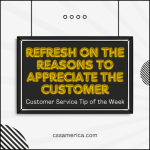
I recently needed two new tires for a vehicle, and I first went to the tire dealer’s website to find some options. The site’s look/feel and ordering process had changed, and I didn’t see a tire I wanted, so I called the store to make an appointment.
When I arrived at the tire store (a place I’d been to 15-20 times), it was very different due to COVID-19. There was a tent outside with chairs about 8-10 feet apart. There was a small sign with different directions based on whether you had a scheduled appointment or were a walk-up. The door you normally enter was locked. The inside experience was different – there was no coffee or water while you waited. People were asked to wait outside or sit in their car while the tires were changed. You drive your car into the garage and drive it out of the garage regardless of whether you were in the car while the tires were being changed. There’s no exchange of paperwork unless you requested a small printed receipt when paying.
Virtually everything changed, and to make it work, the customer had to do their part. I asked the employee checking me in how it was going with the new setup, and he said it’s going OK, but “the customers are not reading the signs.”
Customer v. Company Roles
Whereas a customer has a role in their own service experience, particularly in an environment like this, the company has the role to teach that customer about the new experience and the customer’s responsibilities. The company has a role to confirm the customer’s understanding. The company has the role to ensure the comfort and confidence about what’s going to happen. The company has a role to explain those next steps and timeframes and then, as always in customer service, deliver on the expectation they set.
When the customer has to learn a new way to do business with your company, realize you are in teaching mode. Don’t make your customers become experts in your processes. Make it easy for any customer to have a great experience, even under these new circumstances.
Bring simplicity into your service system, and teach customers how to have a great experience.
Signup for FREE Tips! Contact Us More Resources for You Visit Our Home Page
 You may have heard references in management theory over the many decades about the importance of a business being an “Agile” organization, but oftentimes that is a word thrown out in generalities to illustrate vague points about how organizations should be managed and make decisions. In this time of COVID, however, the definition of an Agile business and how that comes into play in a real world, real-time situation has rarely been so clear.
You may have heard references in management theory over the many decades about the importance of a business being an “Agile” organization, but oftentimes that is a word thrown out in generalities to illustrate vague points about how organizations should be managed and make decisions. In this time of COVID, however, the definition of an Agile business and how that comes into play in a real world, real-time situation has rarely been so clear.













 Change can result in fear. Particularly where change is thrust upon someone very suddenly, it can create shock or disbelief. Sometimes that change is not something an organization can plan for; it therefore cannot adequately prepare its employees for what’s ahead…at least initially.
Change can result in fear. Particularly where change is thrust upon someone very suddenly, it can create shock or disbelief. Sometimes that change is not something an organization can plan for; it therefore cannot adequately prepare its employees for what’s ahead…at least initially.








